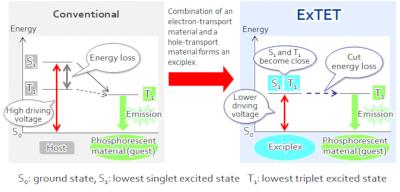In 2016, Researchers from Japan's Semiconductor Energy Laboratory (SEL) announced a new OLED device architecture, called ExTET ('exciplex triplet energy transfer'), that can increase the performance of OLED devices. The technology was applied for a patent in 2011.
The ExTET technology, which is a modification of the host material and the EML layer in phosphorescent OLED devices, have since been introduced to commercial AMOLED panels, increasing the efficiency and lifetime of the materials, while also lowering the drive voltage.
In recognition of the ExTET technology, SEL has been awarded with Japan's National Invention Commendation Award in 2018. SEL has built a comprehensive patent portfolio with a wide geographical coverage including the U.S., Japan, China, South Korea and Germany covering the ExTET technology. One of the basic German patents was opposed in 2018 and has recently been upheld in slightly amended form by a final decision of the Federal Patent Court of Germany.
SEL explains that in a phosphorescent OLED, the excitation energy of a host material is transferred to a phosphorescent material in the light-emitting layer, so that the phosphorescent material emits light. ExTET is an energy transfer mechanism in which an exciplex formed by combination of an electron-transport material and a hole- transport material is used as a medium for energy transfer to a phosphorescent material in the light-emitting layer. ExTET’s improved energy transfer reduces energy loss, and thereby increases emission efficiency, reduces driving voltage, and extends the lifetime of phosphorescent OLEDs.
SEL says that ExTET is now an essential part of OLED displays, and is a "fundamental technology used in the green- and yellow-light-emitting layers of commercially available OLED displays, and sometimes also used in red-light-emitting layers".


